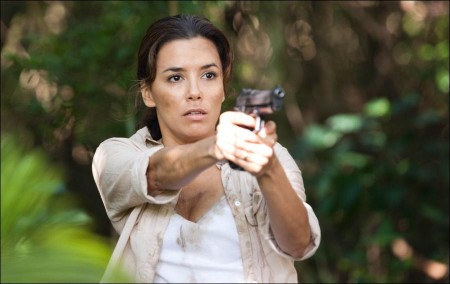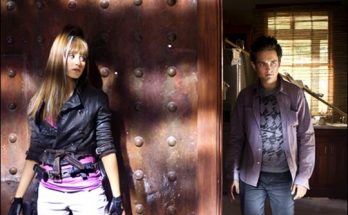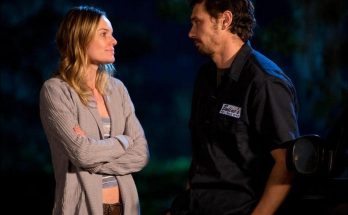Taglines: Escape the jungle. Expose the truth.
Andy Garcia, Kim Coates, Deborah Kara Unger, Eva Longoria and Forest Whitaker star in A Dark Truth, written and directed by Damian Lee. Garcia plays a former CIA operative turned political talk show host, who is hired by a corporate whistle blower to expose her company’s cover-up of a massacre in a South American village.
When he arrives, he is plunged into a violent and chaotic situation, with the military cracking down on a group of protesters led by a pair of activists (Eva Longoria and Forrest Whitaker). The ever-increasing depletion of earth’s natural resource of water serves as the backdrop for this tense environmental thriller. It premiered at the 2012 Boston Film Festival and was released theatrically in the United States on January 4, 2013.
About the Production (2013)
In a story filled with a core mythical ethos of family, power and corruption, the provocatively titled thriller A DARK TRUTH focuses on the exposure of evil corporate deeds, greed and misconduct in the third world being brought to light.
The film draws attention to man’s inhumanity and unconscious actions against the environment and questions if there is a moral and ethical obligation when talking about boundaries, borders and human interaction. With the ever-increasing depletion of earth’s natural resource of water serving as the backdrop, a multi-national corporation disregards basic human needs that result in widespread illness and a people’s uprising. The distress causes unlikely allies to conspire and seek redemption for past deeds and the greater good.
Writer / director Damian Lee was researching a project dealing with water problems and concerns on a global basis when he discovered the real-life South American water wars which happened when a major multinational corporation bought up the water rights in a couple of countries.
Reportedly, with the leaders of the governments personally pocketing the millions of dollars none of that money trickled down to the people who really could have benefited from the sale of the natural resources. In fact, it even became illegal for peasant farmers to collect rain because all water was controlled by the multinational. There was a revolt in the streets, and soldiers moved in to protect the corporate rights of the companies that bought the water rights.
“I looked at this as there being a terrific water story dealing with the abuse of power, selling out your fellow countrymen and corporate greed,” said Lee. Inspired by this, he developed and wrote his original screenplay and brought it to his longtime friends, producers Gary Howsam and Bill Marks. They agreed to produce the film and have Lee direct.
The director wanted Andy Garcia in the lead role of Jack Begosian, a former CIA operative who is now a good family man and an outspoken talk radio host who lives with regrets from his past government misdeeds.
Upon reading the script, Garcia had a subconscious reaction. “It stimulated and enlightened me. I got lost in its story and themes of abuses in countries of the world being brought to light,” the actor noted. “Its social consciousness is very important.”
With Garcia aboard, it helped the producers to drive the project forward for finding financing and attracting other actors. “He immediately brought gravitas and validity to the project,” recalled producer Gary Howsam.
When Forest Whitaker, a UNESCO Goodwill Ambassador for Peace and Reconciliation, received the script, he was first intrigued by the title. He then found the role of Francisco Francis and the story compelling. Although he had never worked with director Lee, he felt anyone who could write such an insightful piece had an interesting sensibility that he wanted to learn more about.
“It brings something to the world. It offers a deep message of our connectivity and how we deal with our resources,” Whitaker said.
The character of Francisco is an anthropologist and ecologist. He learned that when the Clearbec Corporation was privatizing water in Ecuador, it caused a typhus epidemic and a village massacre. He takes this information and fights for the common people. He wants to spread the message to the world of what happened so these events and corporations can be stopped and they will not be allowed to happen again. During a time when he was falsely imprisoned for his activities, he wrote a book entitled Presence is Born that is about how consciousness permeates everything in one’s life. Later, upon meeting Garcia’s Jack Begosian, he leads him on a path of redemption from the wrong and hurt Begosian did when he was with the CIA.
“Forest is a very conscientious, bright, articulate human being. He’s a very transcendental actor who brings a spiritual element to the screen in his performance that is far moving beyond the script,” said Lee. “From watching him you see how he takes a moment and goes deeper and deeper into the very essence of a character.”
Added producer Bill Marks, “Forest is extraordinary. He brings subtle richness and authentic humility. He is beautifully responsive with his humanity and he transfers that into the portraits of roles he plays.”
This was the second time that Garcia and Whitaker have worked together on screen, the first time being on The Air I Breathe. “His genial talents as an actor and his warm heart as a person personifies him and his character,” noted Garcia.
Francisco talks about being a part of La Vía Campesina, peasant farmers who banded together after being pushed out by larger farming organizations to form conglomerates around the world to protect themselves and their own rights. In his own life, Whitaker is known to be very open to all types of non-governmental organizations (NGOs) that allow work to be of an equality and equity among the people. As such, he was able to bring his own personal insights and experiences to the role. He had done some work with UNESCO on small island development where islands such as in Fiji are sinking and shorelines are being eroded, so he was already well aware of water issues. He is also active with the International Institute for Peace, based at Rutgers University and under the auspices of UNESCO, which promotes research on cutting-edge issues relating to peace-building. The Institute participates in real-life mediations of communities in conflict and brings unique expertise in addressing the violent conflicts that take place in cities, particularly among youth and gangs.
Whitaker and the Institute deal with an area they call Peace and Water, with a stance that water is generally a natural resource that should belong to the people or at least a government or state. Yet water has caused many conflicts on the planet and will cause many more because of dying resources. He understands the notion that privatizing water is necessary in certain areas and that someone is going to have to bring it in. Hopefully, he said, it will be the state because when a private organization is handling water reserves there can be a lot of problems that could ensue such as looking only at profit margins that could sway the water consumption and its rates.
“A Dark Truth is a call to action. It’s an awakening for us to recognize what we are doing to the planet and how it is affecting other people and that we need to do something about it,” proclaimed Whitaker.
Eva Longoria was sent the script by Garcia, with whom she is a friend and had worked with on another project entitled Cristiada. “I thought it was a fantastic screenplay. I was excited at the thought to work with Andy again and to play Forest’s wife,” said Longoria. “Forest is a power and it’s amazing how he can move you in a moment from amazed to crushed.”
She already knew Damian Lee since they had been developing another project together. He loved the idea of her playing Francisco Francis’ wife, Mia, an environmental activist. The role is very physical complete with two young kids, shooting guns, running, getting down and dirty in the jungle, and riding all-terrain vehicles (ATVs).
“There’s a tomboy aspect to her that is surprising. She’s completely unpretentious,” said director Lee. “She strikes me as a dynamic person with her energy, someone who is heartfelt, wonderfully bright and effervescent.”
Deborah Kara Unger plays Morgan Swinton, a character that is antithetical to her in her own life. A troubled socialite, she has narcotized herself and feels ineffective and anonymous any time she attempted to find meaning in her spoiled life. She has dulled herself and her senses to the world. As the sister to Bruce, CEO of the family’s company Clearbec, which privatized the water in Ecuador, and, in turn, caused the typhus epidemic that also led to an uprising among the peasant farmers, she develops a conscience due to the negative deeds that surround her and the family name. Garcia’s Begosian serves to awaken her to this. She tries to right the wrongs that her family has caused and redeem herself.
“Finding her authentic value without dismissing her as an easily characterized cartoon has been fun and I hope that essence has been captured,” said Unger. “Villains are fun, but vilifying is dull.”
Morgan at a starting point in the script is so disassociated that one can’t help but feel bad for the pain she is suppressing. Her escapism is evident and perhaps she is closer to being suicidal. It could be easy to judge her negatively. It was important for Unger to find empathy in embracing the character and that entry point for the actor was sensing the role’s pain. In talks with the director, it became evident to Unger that subliminally Morgan is walking a fine line in terms of her desire to be alive. Unfortunately it takes death for Morgan to reassess the value of being and of human beings. That arc was the journey for the actress.
“Deborah brought incredible sensitivity to the role and always pushed to take more and more risks,” recalled Lee.
Morgan is the sister of Bruce Swinton, the CEO of the family’s water conglomerate Clearbec. He is played by the classically trained and versatile Kim Coates. Coates, who has worked opposite Unger on several other films, had starred in three prior films for director Damian Lee and also served as an associate producer on the film. He brings his wild energy, flashing eyes and maniacal presence to a character he found to be incredibly challenging and full of nuances. It would have been easy to play him in a devilish way with an alpha dog quality, but he really saw him as a guy caught between a rock and a hard place.
“I sympathized with this character. Bruce is overwhelmed and I wanted to play him as real as possible. He really is a good man whose life ends tragically,” Coates noted. As Tor, the hired assassin who does Bruce Swinton’s dirty work, Kevin Durand brings great dimension, nuances and subtleties to the role. He was attracted to the script being an action political thriller that also draws attention to ethics and morals. Begosian is not aware of Tor until they meet. Tor has a crisis of conscience when he listened to conversations Begosian had with his son. On the surface the role of Tor may first seem like he’s just a scary guy doing his job, but ultimately he changes due to conscience and circumstances.
“The script had great fluidity and soul. It took me on a journey,” Durand said. “When I was offered the role I did a funky monkey dance because I was so excited. I loved that the character seems so straight forward but he really turns.”
Writer/director Lee was very open and encouraged his core lead cast to have the freedom to contribute ideas to make the script richer. He wanted to have his actors have an organic feeling of behavior for their characters, nothing pre-designed. A consensus leader with a clear vision, it was very liberating for the actors to have such a strong collaboration with their director.
“Damian inspires risk taking and out of that comes colors that are not expected and that naturally enrich the characters and surprise all of us,” said Unger.
The producers and director had originally planned to shoot the entire film in northern Ontario, Canada. That changed given the timing of the shoot schedule and availability of the actors. They had the opportunity to use two contrasting locales, the cold early winter landscape of Canada and the lush rainforest and tropical weather of the Caribbean. Sudbury, a working class nickel mining town with a population of approximately 160,000, stood in for the city of Toronto. The biggest challenge shooting there was that it was going to be very cold, but ultimately it was mild for the time of year.
The choice to have the Dominican Republic stand in for Ecuador was at the suggestion of Andy Garcia. He had previously directed and starred in The Lost City which he shot on the island. Having spent a lot of time there he had a very positive experience and was already quite familiar with local production companies, vendors, resources, language barriers and logistics. Director Lee went for a visit and fell in love with the place. The region’s diverse topography offered jungles, hills, rivers, mountains, and small villages.
It was more a technical challenge to cheat the town of Sudbury for Toronto. For instance, there was the need to composite in Toronto in the background for interior shots and use 40 feet of green screen to create a second story for a house. Conversely, the greatest challenge in the Dominican Republic was dealing with the logistics of shooting in the jungle. An area known as Heina, located around 30 minutes from the capital city of Santo Domingo, was selected as the main setting. Seven sets, all within minutes of each other, were created. This included the Esmeralda village, sites for the village massacre and burning, and Francisco’s camp. All the film gear, from cameras, electrical generators and lights to food, portable bathrooms and mosquito repellent, along with a full production crew, actors and extras, had to be transported each day and night.
Fortunately, good weather and pre-production planning made it all work. If it had rained the jungle roads would have been impassable. The production also shot in and around the historic Zona Colonial, located in the heart of Santo Domingo.
Visually, director Lee was adamant that given his two locales of Canada and the Caribbean he wanted a very distinct look for each, north versus south. There needed to be strong differentiations of vibrancy and tonality of the two settings. His first discussion with cinematographer Bobby Shore was a meeting of the minds about intent and ambition. Together they had a visual understanding of the esoteric and spiritual concerns that needed to be articulated. They agreed that a colder, monochromatic color palette and softer lighting would reference Toronto. More contrasted lighting and a more saturated color palette of greens, reds and oranges would be for Ecuador.
There were locked off and smooth camera movements used on the Canadian shoot versus shooting in a cinema verite style, using handheld cameras, and making use of only available light in the jungle. For the northern shoot, generally longer lenses were used and not many close-ups. In the south, it was important to open the geography to show the environment of the jungle, so the cameras often moved around the actors.
“Bobby is uncompromising,” noted producer Howsam. “Despite a tight schedule he moves forward quickly while being demanding with shot quality.”
A Dark Truth (2013)
Directed by: Damian Lee
Starring: Kim Coates, Kevin Durand, Forest Whitaker, Steven Bauer, Eva Longoria, Lara Daans
Screenplay by: Damian Lee
Production Design by: Anthony Cowley
Cinematography by: Bobby Shore
Film Editing by: William Steinkamp
Costume Design by: Ton Pascal
Set Decoration by: Patrick Gilbert, María Fernanda Sabogal, Michael Sue
Music by: Jonathan Goldsmith
MPAA Rating: R for violence and disturbing images.
Studio: Magnolia Pictures
Release Date: January 4th, 2013
Visits: 135





